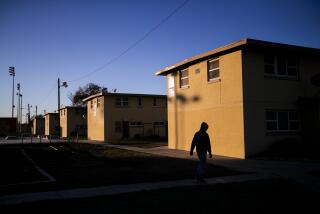Brochure on City Tap Water OKd Over Environmentalists’ Objections
Over objections of environmentalists, the Los Angeles City Council on Wednesday approved a controversial consumer brochure that lists various contaminants in the city’s tap water, but nevertheless declares that it meets state and federal safety standards.
The brochure will be included in bimonthly utility bills that will be mailed to the Department of Water and Power’s 1.3 million customers beginning next month.
The action followed a one-hour debate in which several council members said they had doubts about the quality of the city’s drinking water. They nevertheless agreed that the brochure ought to begin with the hotly debated phrase: “All water provided by the Los Angeles Department of Water and Power meets state and federal water quality standards.”
For weeks, opponents have charged that the phrase is “misleading” because it failed to reflect actual counts of contaminants that have been discovered in the water supply in recent years.
Specifically, in 1986, the federally accepted standard of the organic contaminant trichloroethylene (TCE) was exceeded on three different days. The DWP admits that, but said the federal water quality standards were nevertheless met that year because they are based on an average annual, not on day-to-day levels.
Environmentalists and homeowner groups who fought against the brochure statement said that the fact that the city met the federal standards most of the time did not justify implying that the water was always safe.
But the council felt differently.
Councilman Marvin Braude, who insisted on the brochure’s safety statement, said Wednesday that it is important that consumers know what contaminants may be in their drinking water.
But, Braude added, while the city wants to be “on the cutting edge of (disclosure), we also do not want to frighten anyone.”
Braude sought to end the dispute by inserting a footnote at the end of the brochure that cited excessive TCE levels during the three days in 1986.
But opponents remained unsatisfied, saying that the footnote was merely one of the obvious contradictions to the brochure’s opening statement.
Others also said they had problems with the brochure’s language.
“I think it’s false advertising,” said Councilman Nate Holden, who cast the only vote against the brochure. “Most of us won’t drink the water (because) many of us are afraid to drink the water.”
Councilman Zev Yaroslavsky said he and his family have bottled water at their home and noted that surveys have shown that 54% of the city’s residents apparently refuse to drink tap water, mostly because of the taste.
“We do not drink tap water in this city,” Yaroslavsky said. “I don’t give a damn what Consumer Reports says. . . .” He was referring to a highly publicized survey in which the consumer magazine gave high marks to the city’s tap water.
Yaroslavsky, while stating that the environmentalists had raised “legitimate questions about the language” in the opening statement, nevertheless supported it.
The brochure was developed after the council voted last spring to notify DWP customers of the various bacterial and chemical levels that occurred in the city’s water supply. There will be 12 specially tailored brochures because residents will receive water from various sources depending on where they live in the city.
More to Read
Sign up for Essential California
The most important California stories and recommendations in your inbox every morning.
You may occasionally receive promotional content from the Los Angeles Times.










